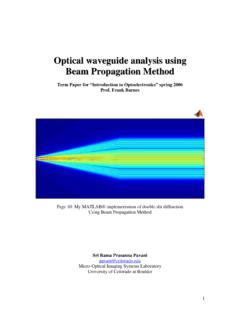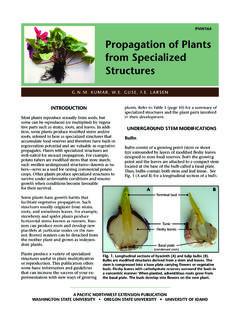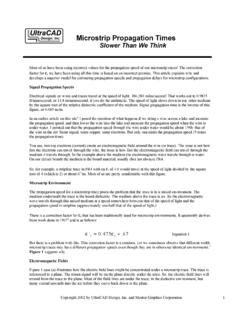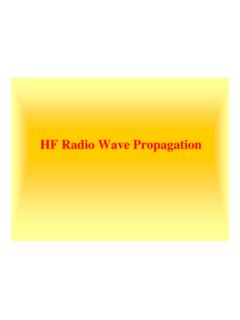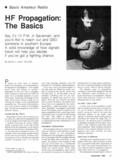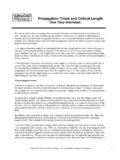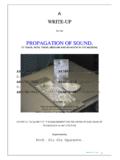Transcription of OVERVIEW OF ELECTROMAGNETIC WAVE PROPAGATION - …
1 Naval Postgraduate School Department of Electrical & Computer Engineering Monterey, CaliforniaEC3630 Radiowave PropagationOVERVIEW OF ELECTROMAGNETICWAVE PROPAGATIONby Professor David Jenn ( )1 Naval Postgraduate School Department of Electrical & Computer Engineering Monterey, CaliforniaPropagation of ELECTROMAGNETIC WavesRadiating systems must operate in a complex changing environment that interacts withpropagating ELECTROMAGNETIC waves . Commonly observed PROPAGATION effects are DIRECT2 REFLECTED3 TROPOSCATTER4 IONOSPHERIC HOP5 SATELLITE RELAY6 GROUND WAVE6 SPACE WAVESKY WAVET roposphere: lower regions of the atmosphere (less than 10 km)Ionosphere: upper regions of the atmosphere (50 km to 1000 km)Effects on waves : reflection, refraction, diffraction, attenuation, scattering, Postgraduate School Department of Electrical & Computer Engineering Monterey, CaliforniaSurvey of PROPAGATION Mechanisms (1)There are may PROPAGATION mechanisms by which signals can travel between thetransmitter and receiver.
2 Except for line-of-sight (LOS) paths, their effectiveness isgenerally a strong function of the frequency and transmitter-receiver geometry direct path or "line of sight" (most radars; SHF links from ground to satellites)SURFACETXRXoo2. direct plus earth reflections or "multipath" (UHF broadcast; ground-to-air and air- to-air communications)SURFACETXRXoo3. ground wave (AM broadcast; Loran C navigation at short ranges)SURFACETXRXoo3 Naval Postgraduate School Department of Electrical & Computer Engineering Monterey, CaliforniaSurvey of PROPAGATION Mechanisms (2)4. tropospheric paths or "troposcatter" (microwave links; over-the-horizon (OTH) radar and communications)SURFACETXRXooTROPOSPHERE5 . ionospheric hop (MF and HF broadcast and communications)SURFACETXRXooF-LAYER OF IONOSPHEREE-LAYER OF IONOSPHERE6.
3 Waveguide modes or "ionospheric ducting" (VLF and LF communications)SURFACETXRXooD-LAYER OF IONOSPHERE (Note: this is not the same as ionospheric hopping. In this case the ionosphere and earth's surface act like a parallel plate waveguide.)4 Naval Postgraduate School Department of Electrical & Computer Engineering Monterey, CaliforniaSurvey of PROPAGATION Mechanisms (3)7. terrain diffractionTXRXooMOUNTAIN8. diffraction by the curved earthSURFACETXRXoo9. low altitude and surface ducts (radar frequencies)SURFACETXRXooSURFACE DUCT (HIGH DIELECTRIC CONSTANT)10. Other less significant mechanisms: meteor scatter, whistlers5 Naval Postgraduate School Department of Electrical & Computer Engineering Monterey, CaliforniaIllustration of PROPAGATION Phenomena(From Prof. C. A. Levis, Ohio State University)6 Naval Postgraduate School Department of Electrical & Computer Engineering Monterey, CaliforniaElectromagnetic Spectrum(From W.)
4 Stallings, Wireless Communications and Networks, Prentice Hall)7 Naval Postgraduate School Department of Electrical & Computer Engineering Monterey, CaliforniaPropagation Mechanisms by Frequency BandsVLF and LF(10 to 200 kHz)Waveguide mode between Earth and D-layer; ground wave at shortdistancesLF to MF(200 kHz to 2 MHz)Transition between ground wave and mode predominance and skywave (ionospheric hops). Sky wave especially pronounced at (2 MHz to 30 MHz)Ionospheric hops. Very long distance communications with low powerand simple antennas. The short wave (30 MHz to 100 MHz)With low power and small antennas, primarily for local use using director direct-plus-Earth-reflected PROPAGATION ; ducting can greatly increasethis range. With large antennas and high power, ionospheric (80 MHz to 500 MHz)Direct: early-warning radars, aircraft-to satellite and satellite-to-satellitecommunications.
5 Direct-plus-Earth-reflected: air-to-groundcommunications, local television. Tropospheric scattering: when largehighly directional antennas and high power are (500 MHz to 10 GHz)Direct: most radars, satellite communications. Tropospheric refractionand terrain diffraction become important in microwave links and insatellite communication, at low Postgraduate School Department of Electrical & Computer Engineering Monterey, CaliforniaApplications of PROPAGATION PhenomenaDirectMost radars; SHF links from ground to satellitesDirect plus EarthreflectionsUHF broadcast TV with high antennas; ground-to-air and air-to-ground communicationsGround waveLocal Standard Broadcast (AM), Loran C navigation at relativelyshort rangesTropospheric pathsMicrowave linksWaveguide modesVLF and LF systems for long-range communication and navigation(Earth and D-layer form the waveguide)Ionospheric hops(E- and F-layers)MF and HF broadcast communications (including most long-distance amateur communications)Tropospheric scatterUHF medium distance communicationsIonospheric scatterMedium distance communications in the lower VHF portion of thebandMeteor scatterVHF long distance low data rate communications9 PROPAGATION of ELECTROMAGNETIC SignalsbyProfessors C.
6 A. Levis1 and D. C. Jenn1. Definition of PropagationInformation can be transmitted in many ways. The use of ELECTROMAGNETIC energy for thispurpose is attractive, in part, because often physical connections are not necessarily requiredThis advantage gave rise to the terms wireless telegraphy and wireless telephony which werecommonly used for radio in the early part of the 20th century. (The term wireless had becomearchaic to engineers, however, it had a rebirth with the proliferation of computer and informationnetworks in the 1990s. Today it is these systems are associated with the term wireless.) Theconnectionless feature of ELECTROMAGNETIC PROPAGATION is utilized in many engineering systems:long distance point to point communications, radar, radio and television broadcasting,navigational aids, etc.
7 The same considerations make ELECTROMAGNETIC energy useful in sensors,systems which obtain information from and about regions to which the energy is sensors are used for measuring the electron concentrations in the Earth s upperatmosphere (and now planetary atmospheres as well), the wave-state of the sea, the moisturecontent of the lower atmosphere, the moisture in soils and vegetation, the size distributions ofparticles in smoke, and many other most or all of these applications it is possible to divide active systems2, at least conceptually,into three parts. The first is the transmitter; it generates the ELECTROMAGNETIC energy in anappropriate frequency range with the desired time waveform, superimposes on it whateverinformation is to be sent, and launches the resulting signal toward the receiver or the region to besensed.
8 The last is the receiver; it accepts some fraction of the energy which has beentransmitted and extracts from it the desired information. PROPAGATION is the link between thetransmitter and receiver, , the process whereby the information bearing energy or signal, isconveyed from the transmitter in the PROPAGATION and Systems DesignPropagation considerations can, and usually do, have a profound influence on systems are therefore of great importance to the systems engineer as well as to the propagationspecialist. For example, consider the White Alice system, a communication system implementedin Alaska and northern Canada during the late 1950s. It was designed partly for generalcommunications needs and partly to convey information from the Distant Early Warning (DEW)line to Command Centers of the US Defense forces.
9 Note that this was before the advent ofsatellites, so a terrestrial radio communication link was the only possible solution at the time. 1 Based on unpublished notes by C. A. Levis, Ohio State University, modified and expanded by D. C. Jenn, NavalPostgraduate School2 An active system is one that has its own source of radiation ( , a transmitter) as opposed to a passive system thatonly receives ELECTROMAGNETIC radiation. Passive systems can receive radiation that is transmitted by other activesystems, or radiation that is emitted naturally by objects and the environment. Infrared night viewers are anexample of the latter that operate in the infrared regions. Passive sensors that operate in the microwave andmillimeter wave regions are called establishment and maintenance of telecommunications centers in the inhospitableenvironment of the Arctic is a difficult and expensive matter.
10 In the high-frequency (HF) band itis possible to transmit signals for very great distances with very modest equipment and antennas a fact well know to radio amateurs (ham operators). Thus HF systems might seem to be thecheapest solution for this application. There are however several drawbacks to this ready PROPAGATION of the HF signals would make an HF system very susceptible tointerference from signals arriving from other parts of the Earth. Also, HF PROPAGATION dependson the ionosphere, an ionized atmospheric region which is strongly influenced by the Sun. Attimes the Sun ejects huge streams of charged particles which severely upset the ionosphere andmake HF communication in the Arctic and sub-Arctic region quite impossible.
